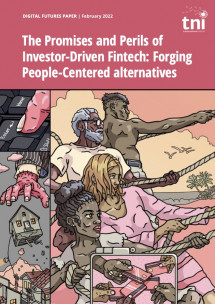The Promises and Perils of Investor-Driven Fintech Forging People-Centered alternatives
Topics
Financial technology, or ‘fintech’, is a widely celebrated recent innovation. However, in this paper we explore how its seductive narrative is a fundamentally flawed and inaccurate portrayal of the emerging reality. While it is clear that fintech offers a major opportunity to improve the lives of the poor if done right, and it has had some important initial successes, its full long-term impact looks far less rosy.

Downloads
Authors
Download the full paper here.
Executive Summary
This paper examines the spectacular rise of ‘fintech’ (financial technology), an innovation that constitues an historic discontinuity in the structure, operations and conduct of financial systems everywhere. The aim is to provide a much-needed corrective to the rapidly proliferating myths and falsehoods surrounding the capacity of fintech to address poverty and promote sustainable and equitable local economic and social development in Low- and Middle-Income Countries (L&MICs) by extending ‘financial inclusion’.
We point out that the basic fintech model is actually an ‘investor-driven’ fintech model that has evolved to overwhelmingly serve the private enrichment and ideological agendas of a narrow global elite composed of venture capitalists and leading investment institutions, the world’s major financial, telecom and digital payments corporations, the main international development agencies (especially the World Bank), well-financed digital advocacy bodies (notably the Bill and Melinda Gates Foundation), the major consultancy companies, and several leading governments in the advanced countries. We argue that the fintech model is being ‘sold’ to governments in the L&MICs on the basis of an almost entirely false premise – that it will deliver major economic and social benefits to all citizens – when the evidence suggests otherwise.
The poor have undoubtedly enjoyed many initial gains as a result of the spread of fintech applications, including reduced costs of, and greater access to, many important financial services. These are not inconsequential benefits. However, like many financial innovations, the initial gains for the poor in L&MICs are increasingly being offset into the medium-to-longer-term by a number of developments that work to undermine and block poverty reduction and sustainable local economic development.
These developments include:
- overlending to microenterprises in the informal economy that has led to destructive competition, falling revenues and incomes, and unviable or short-lived microenterprises;
- the use by crowdfunder and P-2-P lenders of impersonal algorithmic screening methodologies that are disembedded from communities, prone to damaging herd instincts, and driven by the need to maximise short-run financial returns. They avoid support for formal growth-oriented Small and Medium Enterprises (SMEs) that require ‘patient’ long-term, low-cost capital and a local eco-system of institutional support and that are better suited to contributing to sustainable economic and social development;
- corporate exploitation of payments streams and remittance flows that undermine the functioning of important social solidarity networks;
- massive expansion of individual over-indebtedness, particularly of young people, that leads to poverty, increased vulnerability and suffering;
- the creation of a more sophisticated criminogenic environment;
- above all, ushering in an entirely new form of ‘digital extractivism’ that is lavishly rewarding global investors and providing a boost to the advanced economies through profits repatriation, while hindering the development of the economies of the L&MICs and causing seriously adverse social impacts, notably rising inequality.
We end the paper by briefly discussing the potential of a practical alternative to the dominant investor-driven fintech model. The experience of a ‘popular fintech’ model that has been deployed since the mid-2010s in the city of Maricá in south-eastern Brazil shows how it is possible for basic fintech applications to be directly used to promote the common good. Piloted by the city government and involving a community digital currency, the Mumbuca, that is managed by the city-owned community development bank, the Mumbuca Bank, the emerging ‘Maricá Model’ has deployed basic fintech applications in such a way as to substantively address local poverty and rising inequality, promote sustainable local enterprise development, extend social justice through the retention and reinvestment of community-based wealth, and to enhance democratic participation in economic life. Maricá’s ‘people’s fintech’ model provides numerous pointers as to how governments in the L&MICs might deploy and manage basic fintech services on behalf of the many and not just the few.
Ilustration by Zoran Svilar


